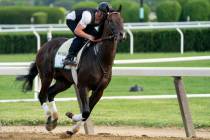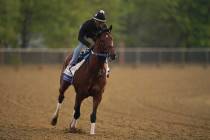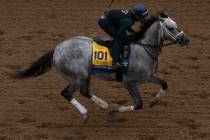Tips from an expert on making your own morning line
I wrote a couple of months ago about a powerful tool that can help you improve your betting strategy and promised to return to the subject. I’m doing that today with a little help from a friend.
First a brief refresher on the concept of making your own morning line when you handicap a race: The object is to help you find horses that offer value because their chances of winning are better than the public perceives.
The best way to do that is to use the simple formula below to ensure that your estimated odds on a horse are fair, not just ballpark guesses.
To begin with, you need a target: For simplicity’s sake, let’s use a range of 122 points (for short fields of five or six horses) up to 130 points for full fields. So in the case of Saturday’s eighth race at Keeneland, which has 13 entries, we’d use 130 points. Simple, right?
Next go through the race and assign odds to each horse that you believe reflect its chances of winning.
When you’re done, calculate the field’s total points using this chart. The total based on your odds should be within a point or two of 130. If it’s not, go back and “massage” your odds until it is.
My friend, a former racetrack linemaker, has been out of the business for a few years, but the concepts he mastered still hold true and can benefit you. Here are a couple of simple ones to get you started, with more coming the next time we return to this subject.
The first is to understand the difference between a racetrack’s morning line and yours. My friend calls the track’s version the “will be” line, because it represents the linemaker’s prediction of how the public will bet. Yours is a “should be” line, or your estimation of each horse’s true odds of winning.
The two should not be viewed as disconnected: You will occasionally miss something that the track’s linemaker considers important. When that happens, re-examine your reasoning and look for anything that might have escaped your attention. If you remain confident in your assessment and the actual odds during wagering resemble the track’s line, head to the betting window. (Caveat: Some sharp players I know demand a 50 percent premium. In other words, if you think a horse’s fair odds of winning are 2-1, demand at least 3-1 before betting.)
The second piece of advice my friend shares this week is that it pays to “get to know your linemaker.” In other words, if you play a track regularly, develop a profile of the track’s linemaker just as you would the track itself. Is he good at assessing first-time starters? Does he take a stand and try to pinpoint exact prices on heavy favorites? Those are just a few of the questions you’ll want to be able to answer.
Stay tuned for more, but now let’s handicap.
#RJhorseracing featured races
This week our intrepid handicappers tackled Saturday’s $500,000 Claiborne Breeders’ Futurity and the $1 million Shadwell Turf Mile at Keeneland, both of which have Breeders’ Cup implications.
In the Futurity, our ’capping corps likes 2-1 favorite Free Drop Billy, followed by Enticed (15-1) and Ezmosh (6-1). I’ll throw my lot in with Enticed, who looks to have a lot of upside.
In the Shadwell Mile, the crew sides with the second choice, Heart to Heart (7-2), over favored Miss Temple City (3-1) and a real bomb, Le Ken (30-1). I’ll stick with Miss Temple City to defend her Shadwell title against the males.
Reader Tom Mahoney gets the mints this week for his astute comment, which has nothing to do with horse racing: “No quips this week. I’m sick at heart.”
Join in next week by dropping me an email or following along on Twitter (hashtag #RJhorseracing).
Contact Mike Brunker mbrunker@reviewjournal.com or 702-383-4656. Follow @mike_brunker on Twitter.
Ellis Starr's analysis
Claiborne Breeders' Futurity
Ezmosh has run three times and improved each time since his debut. Although he is running around two-turns for the first time, his win at a mile (around one-turn) last month was very impressive. Javier Castellano rarely rides for this trainer, Brad Cox, but when they team up they are 7 for 17 (40 percent). Bourbon Resolution is another horse that has run three times and who comes into the race off a win that win earned the best last race figure of any horse in the field, 94. He is bred to run even better around two turns. Enticed gets a disadvantageous outside post in this 1 1/16-mile race, but he comes from behind and may not lose too much ground. He won his only start and his dam (It's Tricky) was a multiple grade 1 winner who earned better than $1.6 million Note: Enticed is also entered to run in the Champagne Stakes at Belmont Park on Saturday.
Shadwell Turf Mile
Suedois and Mondialiste share the same owner and trainer, but because this is a graded stakes they don't run coupled for betting purposes. That is great for bettors, because they will both offer good odds. Suedois just won a Group 2 stakes at a mile in Ireland and gets Lasix for the first time, with regular rider Tudhope taking the call. Mondialiste is better known to North American bettors as he won the 2015 Arlington Million and the 2016 Woodbine Mile, both Grade 1s, and finished second in the Breeders' Cup Mile in 2015 at Keeneland. He's also a true miler. Miss Temple City is the best of the North American contingent, as she not only beat males in the spring of 2016 in the Maker's Mile but won last year's running of the Shadwell Mile.
Ellis Starr is the national racing analyst for Equibase. Visit the Equibase website for more on the race or to purchase handicapping products. Also check out his free daily pick at Keeneland.

















